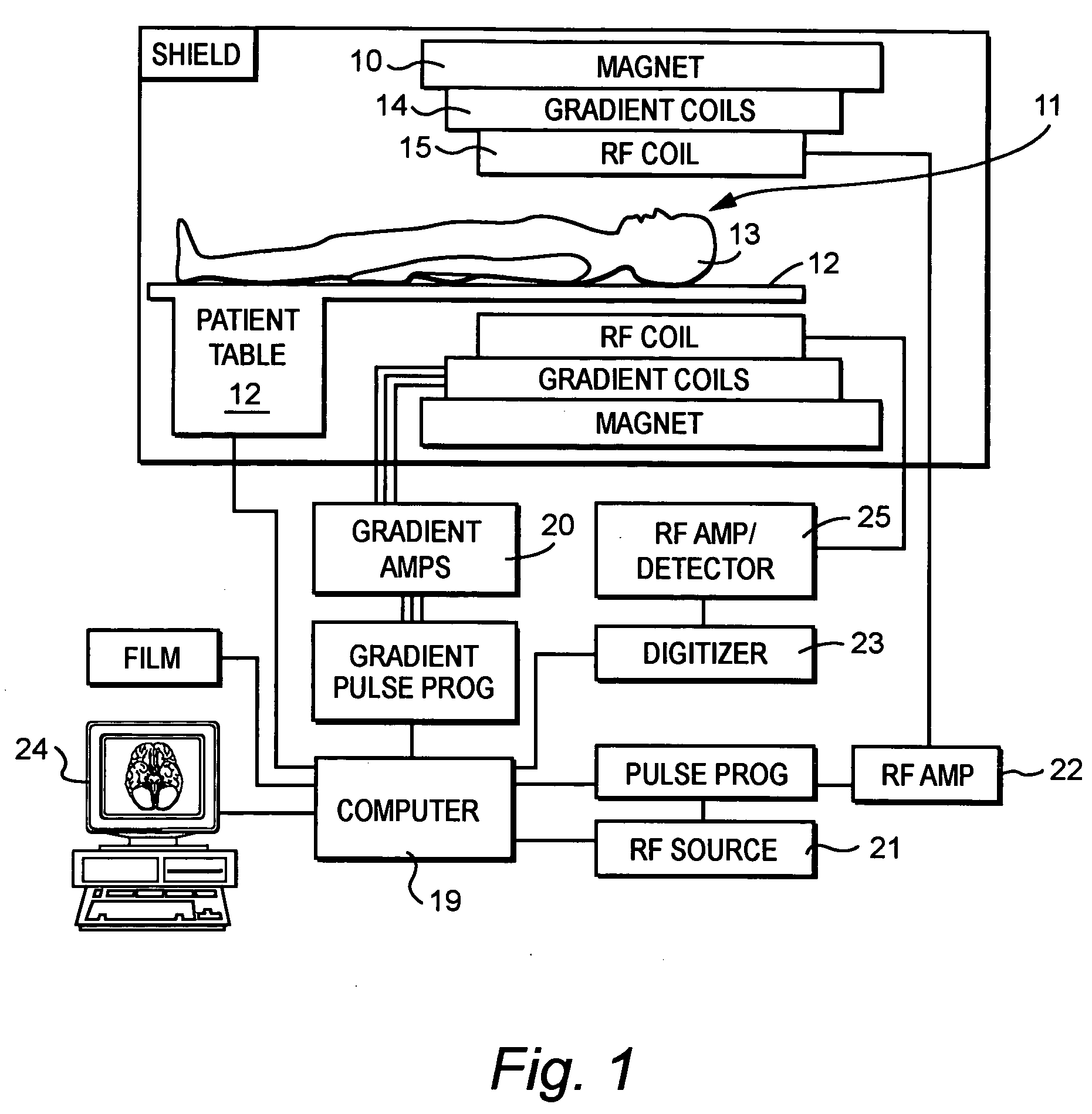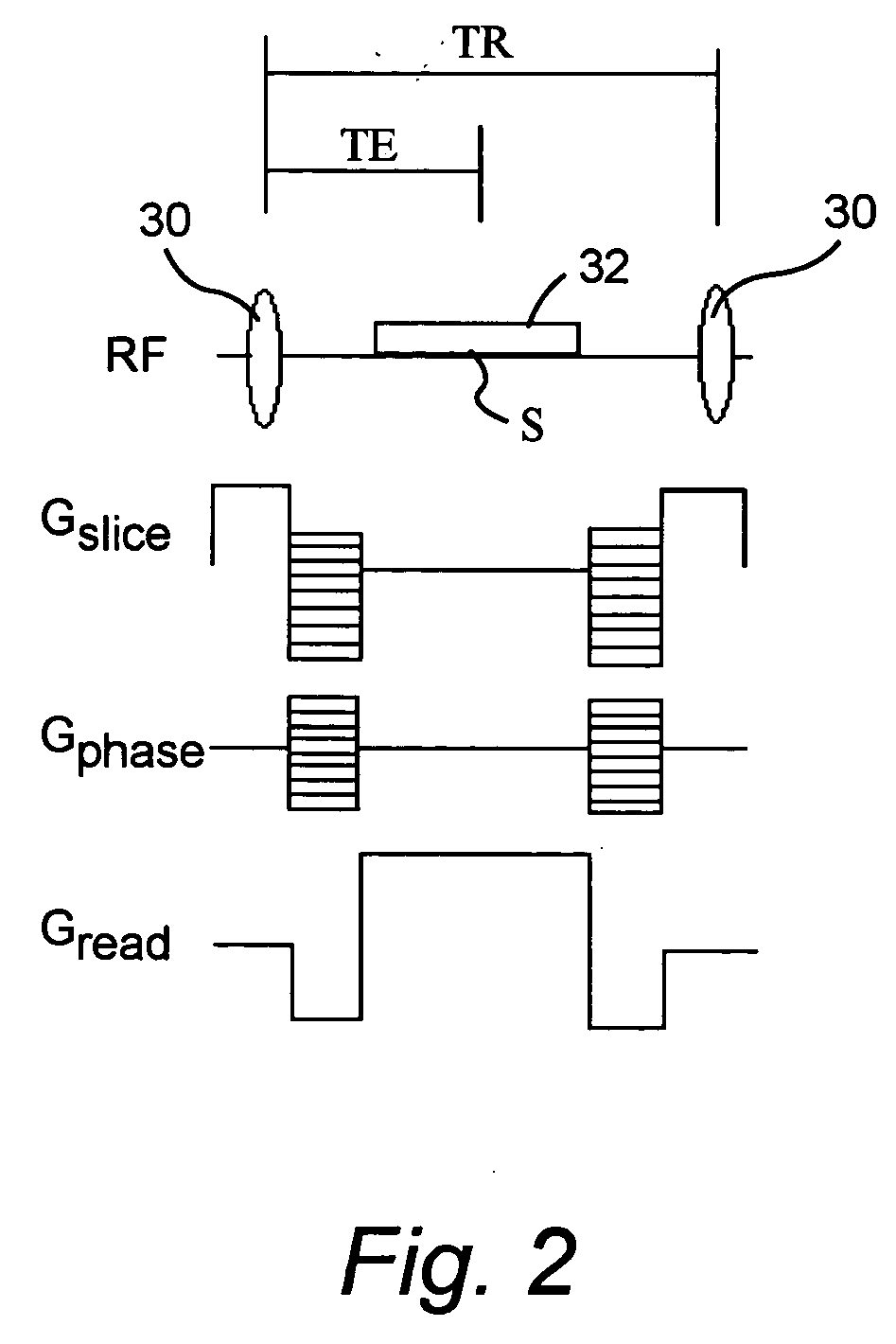Water fat separated magnetic resonance imaging method and system using steady-state free-precession
a magnetic resonance imaging and steady-state free-precession technology, applied in the field of water fat separated magnetic resonance imaging method and system using steady-state free-precession, can solve the problems of limiting the clinical usefulness of ssfp images in many applications, band artifacts, etc., and achieve good water-fat separation and reduce scan time
- Summary
- Abstract
- Description
- Claims
- Application Information
AI Technical Summary
Benefits of technology
Problems solved by technology
Method used
Image
Examples
first embodiment
[0026] In a first embodiment, TR and TE are selected so that water and fat signals are orthogonal in S0 and anti-parallel in S−1. This can be accomplished, for example, by selecting TR and TE according to:
TE=(2j+1) / (4Δf) and TR=(6j+3) / (4Δf), j=0, 1, 2, . . . (11)
At 0.35 Telsa, one such selection corresponds to TR=15 milliseconds (ms) and TE=5 ms (j=0). The acquired SSFP signals after echo isolation can be described as:
S0=(W0+iF0)eiφ (12)
S−1=(W−1−F−1)e−i2φ (13)
A field correction map can be estimated from S−1 according to the following relationship:
−4φ=unwrap{arg(S−12)} (14)
where unwrap{ } stands for the mathematical process for phase-unwrapping such as is described in U.S. Pat. No. 5,909,119, (which is incorporated by reference) and arg( ) returns the principle phase value of its complex input.
[0027] Correcting the S0 image by the phase correction map yields:
S0corr=S0e−iφ=W0+iF0 (15)
and water-fat images can finally be constructed directly from S0corr according to: ...
second embodiment
[0028] In a second embodiment, TR and TE are selected according to a commonly used TR=2TE condition such that water and fat signals are orthogonal in all isolated echo signals. This can be accomplished by selecting TR=2TE=(2j+1) / (2Δf) with j=0, 1, 2, . . . At 0.35 T, one such selection corresponds to TR=10 ms, TE=5 ms. After isolation, the echo signals, can be described as:
S0=(W0+iF0)eiφ (18)
S−1=(W−1−iF−1)e−iφ (19)
S1=(W1−iF1)ei3φ (20)
A combinatory signal is constructed using the following relationship:
S0S1=[(W0W1+F0F1)+i(F0W1−W0F1)]ei4φ (21)
Since it is mostly true that |W0W1+F0F1|>>|F0W1−W0F1|, S0S1 can be approximated by
S0S1≅(W0W1+F0F1)ei4φ, (22)
meaning that the phase of the combinatory signal is dominated by the inhomogeneity angle (φ). A field correction map can be generated according to:
4φ=unwrap{arg(S0S1)} (23)
The S0 and S−1 images are phase-corrected using the field correction map (4φ) and used to finally yield water and fat images (Iw and If respectively) d...
third embodiment
[0029] In a third embodiment, a phase-cycled SSFP master scan is accompanied with a low spatial resolution “assist” scan. For the assist scan, the TR and TE values, TRa and TEa, are selected such that water and fat signals are orthogonal in S0 and anti-parallel in S−1. The TR and TE values, TRm and TEm, are selected for the master scan such that water and fat signals are significantly orthogonal in both S0 and S−1. We therefore have:
S0a=(W0a+iF0a)eiφ0a (32)
S−1a=(W−1a−F−1a)e−iφ−1a (33)
S0m=(W0m+F0meiψ0m (34)
S−1m=(W−1m+F−1me−iψ−1m)e−iφ−1m (35)
where
φ0a=γΔB0TEa (36)
φ−1a=γΔB0(TRa−TEa) (37)
φ0m=γΔB0TEm (38)
φ−1m=γΔB0(TRm−TEm) (39)
ψ0m=2πΔfTEm (40)
ψ−1m=2πΔf(TRm−TEm) (41)
A low spatial resolution field correction map is generated from S−a according to:
−2φ−1a=unwrap{arg(S−1a·S−1a)} (42)
The correction map is applied to correct the isolated echo images from the master scan to yield: S0m,corr=S0mⅇ-ⅈϕ-1a(TEmTRa-TEa)=W0m+F0mⅇⅈψ0m(43)S-1m,corr=S-1mⅇ-ⅈϕ-1a(TRm-TEmTRa-TEa)...
PUM
 Login to View More
Login to View More Abstract
Description
Claims
Application Information
 Login to View More
Login to View More - R&D
- Intellectual Property
- Life Sciences
- Materials
- Tech Scout
- Unparalleled Data Quality
- Higher Quality Content
- 60% Fewer Hallucinations
Browse by: Latest US Patents, China's latest patents, Technical Efficacy Thesaurus, Application Domain, Technology Topic, Popular Technical Reports.
© 2025 PatSnap. All rights reserved.Legal|Privacy policy|Modern Slavery Act Transparency Statement|Sitemap|About US| Contact US: help@patsnap.com



